- Heart patterns
- Lung disease patterns
- Spleen disease patterns
- Introduction
- Causes and etiology of spleen patterns
- Clinical patterns and pathology
- Diagnosis and differential diagnosis
- Stomach disease patterns
- Liver patterns
- Large intestine, San Jiao, and gall bladder patterns
- Introduction
- Causes, etiology, and pathology of large intestine and gall bladder patterns
- Clinical patterns and pathology
- Diagnosis and differential diagnosis
- Kidney patterns
- Small intestine and bladder disease patterns
Heart patterns
Introduction
Heart patterns refer to the identification of clinical patterns by studying the pathology and changes in the physiology of the heart, as well as the etiology and treatment of the patterns.
The clinical patterns of an organ system depend upon the nature of the pathological factor(s) involved and the physiological characteristics of the organ system. For instance, invasion of Cold will present patterns associated with cold, such as a white/pale face or a slow pulse. The stomach, intestines, and uterus are vulnerable to cold invasion.
Heart belongs to Fire and is subject to Heat/Fire invasion. Heart is associated specifically with Blood, Mind, Blood Vessels, tongue, and emotions such as excessive joy, sadness, or anger.
Causes and etiology of heart patterns
The origins of heart patterns include internal (emotions such as overjoy, sadness, anger, or worry), external (Heat), and other causes (improper diet, sedentary lifestyle, smoking, overexertion, weak constitution, toxic substances) .
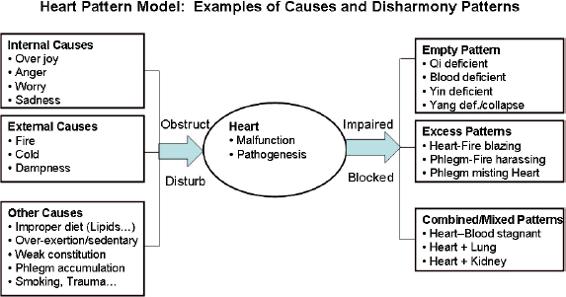
Clinical patterns and pathology
The clinical patterns of the Heart can be manifested as (1) imbalance of physiological function — deficiency/excess or discoordination, and (2) disharmony of Yin–Yang and Qi-Blood of the Heart.
In general, the Yin–Yang aspects of an organ system represent the functional state of the system, while the Qi-Blood aspects of an organ system provide the material basis of its physiological activities. Imbalances of Qi-Blood may precede imbalances of Yin–Yang.
The major clinical signs and symptoms associated with patterns of the Heart are:
- Palpitations (chart, discussion).
- Stuffiness of the chest and/or pain.
- Changes of the tongue tip and lips (red, ulcer, purple–blue, spots), tongue movement, and face.
- Mental restlessness/depression.
- Insomnia and dream-disturbed sleep (increased dreaming).
- The pulse may be Knotted–Intermittent, Empty–Big, Thread–Rapid, Scattered–Big–Rapid, or Slow–Choppy, especially at the left front position.
- Tender pressure points (HT 7, BL 15, CV 17, CV 14).
- Others (poor memory, periods of uncontrolled laughing or crying, coma, etc.).
Lung disease patterns
Introduction
The lungs are situated in the chest, and the Lung Meridian connects with the Large Intestine Meridian, forming an interior–exterior Zang–Fu pair. The lung controls Qi, respiration, skin, and hair, is linked to the nose, and regulates the dispersion of Qi to keep the passageway of water open.
- The Lung is close to the external environment and is subject to External Pathogenic Influences (EPIs) — a “delicate organ.”
- The Lung governs Qi and respiration and is associated specifically to some degree with Qi, Blood, Fluid, skin, nose, body hair, and some emotions (sadness, worry).
- Lung patterns often are related to disharmonies of Qi and respiration, dispersing and descending, regulation of water passages, and Phlegm retention.
Causes and etiology of lung patterns
The causes of Lung patterns include internal (sadness, worry), external (Wind, Cold, Heat, Dryness), and other causes [smoking (voluntary or involuntary), indoor air pollution, improper diet, special body position at work, Phlegm, over exertion or no exertion, constitution, toxic substances].
The general model of Lung syndrome. It illustrates the causes, their interaction with the body, pathological changes, and the common clinical syndromes of the Lung.
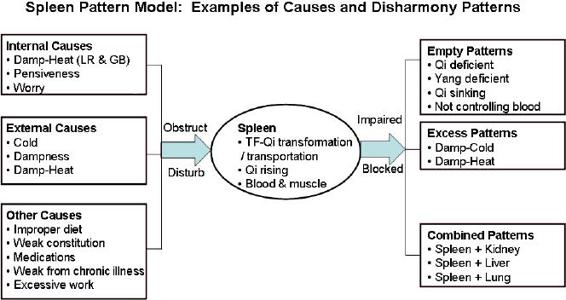
Clinical patterns and pathology
Clinical patterns of the Lung can be manifested as (1) an imbalance of physiological function — deficiency/excess or dis-coordination, and (2) disharmony of Yin–Yang and Qi-Blood of the Lung.
The key clinical manifestations associated with the Lung are:
- Cough (dry or wet), Sputum (white/yellow, clear/sticky, with blood?).
- Shortness of breath, especially on exertion.
- Sweating or dry skin.
- Stuffiness of the chest and/or pain.
- A hoarse/weak voice, inability to make sounds.
- The tongue may be normal or there are some changes in lung area (next to the tip).
- The pulse may be Floating–Rapid/Slow, Empty, or Slippery, especially at the right front position.
- Tender pressure points (LU 9, BL 13, LU 1).
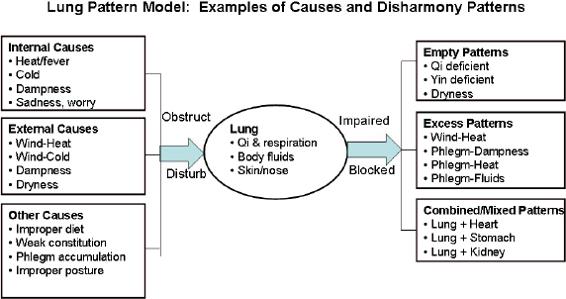
Spleen disease patterns
Introduction
The Spleen likes dryness and is more susceptible to dampness and sweet food. It governs the transformation and transportation of food Qi, and the raising of Qi. It is associated specifically with Qi, Blood, muscles, the mouth, and some emotions (pensiveness, worry). Spleen syndromes often are related to disharmony of the transformation and transportation of food and fluids.
Causes and etiology of spleen patterns
Spleen patterns may be brought about by internal (pensiveness, worry, studying/thinking for a long time), external (Dampness, Cold, Heat), and other causes (improper diet, Phlegm, bleeding, chronic conditions of the body, weak constitution, toxic substances). Both environmental circumstances (damp environment/house, foggy or rainy weather) and living habits (wearing wet clothes after swimming/exercising, improper eating habits, etc.) are important.
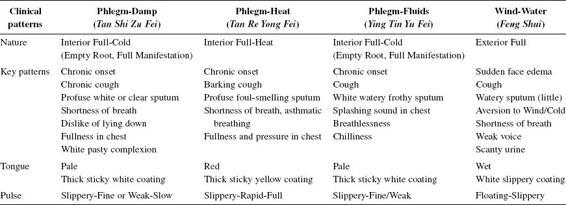
Similar to other internal organ syndromes, Spleen syndromes are illustrated in the following chart, which demonstrates the etiology, pathology, and three categories of Spleen patterns.

Clinical patterns and pathology
The clinical patterns of the Spleen can manifest as: (1) an imbalance of physiological function — deficiency/excess or dis-coordination, and (2) disharmony of Yin-Yang and Qi-Blood of the Spleen.
The clinical manifestations may relate to the nature/characteristics of the cause(s) and the constitution of the body. The key clinical manifestations are poor appetite, abdominal distension/pain, loose stools/diarrhea, limb tiredness/heaviness, yellow/sallow complexion, prolapse of organs (stomach, uterus, anus, etc.), frequent bruises, purpura, blood in urine/stools, menorrhagia/metrorrhagia, thick tongue coating (white/yellow/greasy), tooth marks, and slippery/weak pulse (rapid/slow/empty), especially at the right middle position. Tender pressure points assisting diagnosis are SP 3, BL 20, and LR 13.
Diagnosis and differential diagnosis
Diagnosis may be required for some Spleen patterns, such as:
- Deficiency of Spleen-Qi and Spleen-Yang, Spleen-Qi Sinking, the Spleen failing to control Blood.
- Yang deficiency of the Spleen and Kidneys.
- Qi deficiency of the Spleen and Lungs.
- The Spleen being invaded by Dampness-Cold and Dampness-Heat.
Stomach disease patterns
Introduction
The Stomach controls the rotting and ripening of food, the transportation of food Qi, and the descending of Qi. It is associated specifically with body fluid. Stomach syndromes are often related to disharmony of the transformation and transportation of food and fluids.
Causes and etiology of stomach patterns
Stomach patterns may have internal (emotions such as worry or restlessness), external (environmental Cold, Heat, or Dryness) and other causes (improper diet, medication abuse, smoking and alcohol intake, weak constitution, too little or too much exercise, exposure to toxic substances). Among these, problems associated with diet are the most common causes. Note that these causes may coexist and have added or synergistic effects on the body.
The etiology, pathology, and common clinical syndromes of the Stomach。
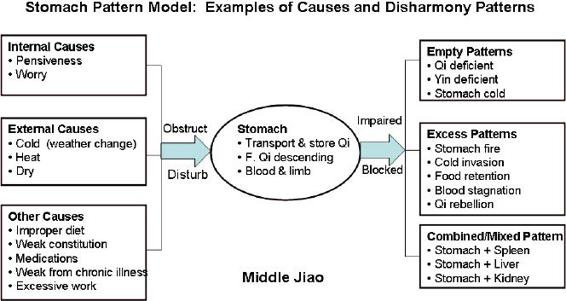
Clinical patterns and pathology
The clinical manifestations of Stomach syndromes occur due to imbalance of physiological function of rotting and ripening food, transportation of food Qi, and Qi descending, or disharmony of Yin–Yang and Qi-Blood of the Stomach. They may relate to the nature or character of the cause(s) and the constitution of the body.
The major clinical manifestations associated with the Stomach are:
- Nausea and/or vomiting.
- Lack of taste sensation and/or changes in thirst.
- Poor appetite, frequent hunger.
- Epigastric discomfort (distension, feeling of heat, burning sensation, pain, etc.).
- Belching and regurgitation (dry, clear, sour; sour fluid and food).
- Loose stools (loose, coarse, smelly)/or constipation.
- General tiredness and weakness (in the morning).
- Tongue change in the center (rootless coating, purple spot in the center).
- Slippery, wiry, weak pulse (Rapid/Slow/Empty), especially at the right middle position.
- Tender points: ST 42 (Chongyang), ST 36 (Zusanli), and BL 21 (Weishu).
Liver patterns
Introduction
The Liver is the organ that ensures the smooth flow of Qi of the internal organs, and the smooth flow of emotions.
Liver syndromes are often related to disharmony of the free flow of Qi and emotions and of storing Blood, leading to manifestations in digestion, emotion, and menstruation. Because of the functional relationship with the tendons, eyes, and Gall Bladder, Liver syndromes are often manifested in the sinews (tendons), eyes, nails, head, and hypochondrium.
Clinical patterns and pathology
The clinical patterns of the Liver derive from disharmony of (1) governing the free flow of Qi, storing/regulating Blood, etc.; (2) specific tissues and orifices — sinews, nails, eyes; and (3) distribution and interconnection of Liver Meridians — head, eyes, hypochondrium, genital region, etc.
The clinical manifestations may relate to the nature/characteristics of the cause(s) and the constitution of the body. The common causes, pathology, and clinical patterns of the Liver are illustrated in following figure .
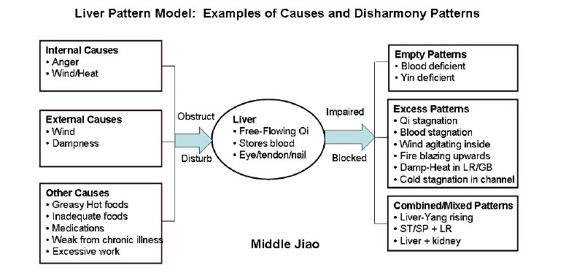
The key manifestations of Liver syndromes are:
- Distension/tenderness/pain in hypochondrium, chest, and breast; being easily tired.
- Irritability, anger, or depression.
- Dizziness, blurred vision.
- Tremor, numbness/spasm of limbs (sinews/muscles).
- Headache, especially in the temples and vertex.
- Jaundice, bitter taste in the mouth, nausea.
- Frequent sighing.
- Irregular menstruation (interval, amount); dry nails that crack easily.
- Skin disorders — dryness, eczema, psoriasis (Blood heat?).
- Tongue changes at the sides.
- Wiry/Slippery pulse (Rapid/Fine), especially at the left middle position.
- Tender pressure points (LR 3, BL 18, LR 14).
Diagnosis and differential diagnosis
The diagnosis is made based on information (signs and symptoms) collected through the Four-Examinations. The rapid onset or changes of manifestations such as sudden skin rashes, tinnitus, hypochondriac discomfort, irritability and anger, tremor, numbness/spasm, and Wiry pulse are often indicative of Liver patterns.
Differential diagnosis may be required for some Liver patterns, such as stagnation of Liver-Qi vs. stagnation of Liver-Blood, Liver-Yang rising vs. Liver-Fire Blazing vs. Internal Liver Wind Agitating, etc.
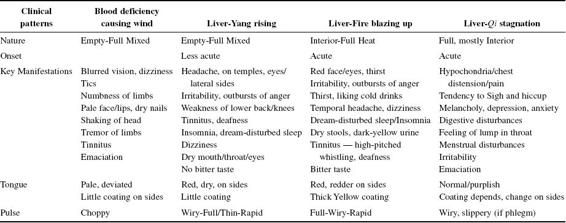
Large intestine, San Jiao, and gall bladder patterns
Introduction
The Large Intestine, San Jiao, and Gall Bladder are Fu organs that transport and/or transform Qi or provide a passage/avenue for Qi movement. They are paired with the Lung, Pericardium, and Liver, respectively.
These organs are vulnerable to Dampness and Heat/Cold invasion.
Important Qi pathways — likelihood of blocking/obstruction.
The clinical patterns can be put into two categories: (a) dysfunction of Fu organ functions, and (b) impairment of its paired organ functions. These patterns are often related or subordinated to the impairment of the relevant Zang organ.
Causes, etiology, and pathology of large intestine and gall bladder patterns
The causes of these Fu organ patterns are primarily related to diet and emotions. External causes, such as Cold and Heat, may also directly invade some Fu organs (Stomach, Large Intestine, Uterus).
The specific emotions for each Fu organ system agree with the paired Zang organs. For instance, worry and sadness influence the Large Intestine, anger influences the Gall Bladder, fear/shock influences the Bladder, etc.
The San Jiao is not a separate and distinct organ system; rather, it is a functional system like an organ. The patterns of the corresponding organs of each location (San Jiao) may be viewed as the patterns of each Jiao. It is important to note, however, that the San Jiao, especially the Middle Jiao, serves as an important passage or avenue for Qi (especially primary Qi) movement. Thus, blockage of the Middle Jiao could result in manifestations for more than one organ system.
Flow Chart — Etiology and Pathology .
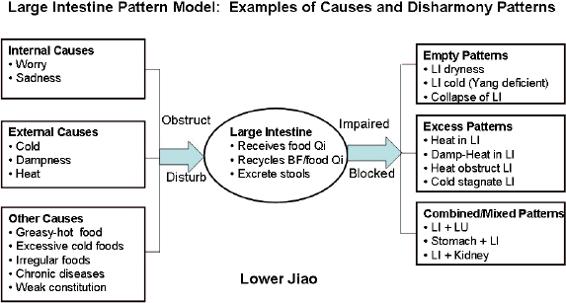
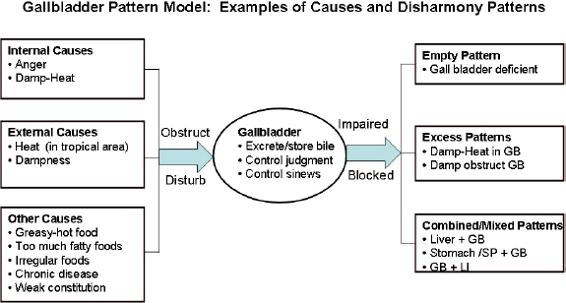
Clinical patterns and pathology
Clinical patterns:
Large Intestine (LI)
Often manifested as (1) imbalance of physiological function — deficiency/excess of the Large Intestine, and (2) disharmony and dis-coordination of the Lung-Large-Intestine organ pair. The anus is often involved. Ulcerative colitis may follow into LI syndrome.
The key clinical manifestations for the Large Intestine are discomfort of the anus (pain, burning sensation, bleeding), bowel movement problems such as diarrhea/dry stools and constipation and borborygmus, lower abdominal distension/pain (spastic), mucus and blood in the stools with an offensive odor, fever (if Heat or Damp-Heat), Sweating (Heat or Damp-Heat), feeling of heaviness of the limbs and body (Dampness)/Cold (Yang deficiency), rootless tongue or yellow thick coating at the root of the tongue, Slippery/Rapid/Wiry pulse (if Dampness/Heat/pain), especially at the right front position. Tender pressure points are LI 4, BL 25, and ST 25.
Gall Bladder (GB)
Often manifested as (1) imbalance of bile physiology — deficiency/excess of the Gall Bladder, and (2) disharmony and dis-coordination of the Liver-Gall Bladder organ pair. Jaundice is often a sure sign of the pattern.
Major clinical manifestations:
Large Intestine
- Discomfort of the anus — pain, burning sensation, bleeding.
- Bowel movement — diarrhea/dry stools and constipation/borborygmus.
- Lower (spastic) abdominal distension/pain.
- Mucus and blood in the stools, with an offensive odor.
- Fever (Heat or Damp-Heat).
- Sweating (Heat or Damp-Heat).
- Feeling of heaviness in the limbs and body (Dampness)/cold (Yang deficiency).
- Tongue change in the root.
- Pulse — Slippery/Rapid/Wiry (Dampness/Heat/pain), especially at the right front position.
- Tender pressure points — LI 4, BL 25, ST 25.
Gall Bladder
- Jaundice.
- Hypochondriac pain/discomfort.
- Inability to digest fats.
- Bitter taste.
- Timidity or lack of courage and initiative.
- Tendency to sigh.
- Scanty dark-yellow urine (if Damp–Heat).
- Tongue change on the side(s) — Thick sticky yellow coating.
- Slippery/Wiry/Weak pulse, especially at the left middle position.
- Tender pressure points — GB 40, BL 19, GB 24
Diagnosis and differential diagnosis
The diagnosis is made based on information collected through the Four Examinations.
The manifestations related to bowel movement and bile physiology/function, such as discomfort of the anus/lower abdomen, and jaundice may provide directions for the Large Intestine and Gall Bladder patterns, respectively.
Like diagnosis for patterns of Zang organs, the diagnosis is based on the three guidelines.
Differential diagnosis may be required for some Large Intestine and Gall Bladder patterns, such as:
- Damp-Heat in the Large Intestine, Heat in the Large Intestine, and Heat Obstructing the Large Intestine.
- Damp-Heat in the Liver and Gall Bladder, and Cold in the Large Intestine and Cold invading the Large Intestine.
Kidney patterns
Introduction
The Kidney is the “Root of prior birth” and stores the Essence and Original Qi. The latter has catalytic effects on the formation of True Qi and Blood, and is the motive force for functional activities of all organs.
The Kidney is the Root of all Yin and Yang — often deficient, rarely in Excess. Chronic diseases will eventually lead to deficiency of Kidney-Yin/Yang.
(Kidney) Essence and Original Qi are related to but different from Kidney-Yin and Kidney-Yang. They come from before and after being born, especially prior to birth. But the former is liquid in nature and circulates all over the body while the latter (derived from Essence) exists in energy form, and is replenished after birth. Essence and the Original Qi are related but different in their functions.
The major functions of the Kidney are to store Essence, govern water, and control the reception of Qi. The clinical patterns are a reflection of these functions.
Causes and etiology of kidney patterns
Kidney patterns derive from internal causes (fear, anxiety, shock, high fever, dampness retention), external causes (damp-heat/cold), and other causes (too much work or excessive sex, a weak constitution such as hereditary vs. non-hereditary — drug/alcohol use or teenage/late-age delivery, old age, too many births, chronic conditions, misuse of herbal medicine, etc. Chronic conditions, which can lead to Heat/Fire/Qi deficiency or impaired Qi movement, are important secondary causes of Kidney problems.
The major pathological changes of Kidney patterns are deficient Kidney Essence and Qi (deficient Kidney Essence, Kidney-Qi being not firm) and dis-coordination of Kidney-Yin and Kidney-Yang (deficient Kidney Yin/Yang).
Flow Chart — Etiology and Pathology.
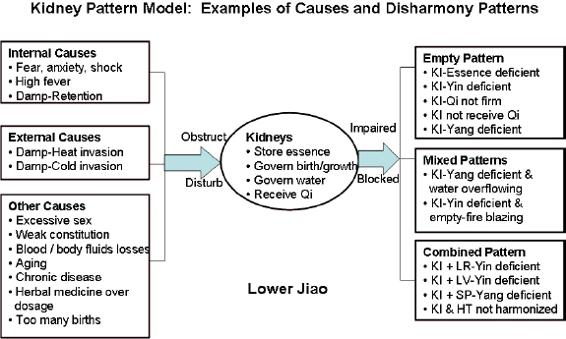
Diagnosis and differential diagnosis
The diagnosis of Kidney patterns is made based on information collected through the Four Examinations.
Using the sore lower back, weak knees/legs, and poor bone development as initial clues, one may efficiently obtain the necessary information for diagnosis and treatment.
Like diagnosis for previous patterns of internal organs, the diagnosis of Kidney patterns is ideally made based on the three guidelines.
Differential diagnosis may be required for some Kidney patterns, such as:
- Deficiency of Kidney Essence and Kidney-Yin.
- Deficiency of Kidney-Qi and Kidney-Yang.
- Deficient Kidney-Yang and Water Overflowing and Heart-Qi deficiency.
- Yang deficiency of the Spleen and Kidney.
- Yin deficiency of the Kidney and Lung.
Small intestine and bladder disease patterns
Introduction
The Small Intestine and Bladder are Fu organs that receive and/or transform (i.e. separate, excrete) Qi and often relate to Body Fluids. They are paired with the Heart and Kidneys, respectively.
These two organs are vulnerable to Dampness and Heat invasion.
They are physiologically related for B.F. transformation, and thus often manifest in urination.
The clinical patterns can be put into two categories: (1) dysfunction of the Fu organ functions; (2) impairment of its paired organ functions. These patterns are often related or subordinated to the impairment of the relevant Zang organ.
Causes and etiology of small intestine and bladder patterns
The causes of Small Intestine and Bladder patterns are primarily related to diet and Dampness, respectively. Emotions also play important roles in the patterns of the two organs.
The specific emotions for each Fu organ system disagree with the paired Zang organs: sadness for the Small Intestine, and feelings of suspicion and jealousy for the Bladder.
Flow Chart — Etiology and Pathology
Clinical patterns and pathology
Clinical patterns:
(a)Small Intestine (SI)
Often manifested as (1) malfunction in receiving and transforming Food Qi and Blood Fluid (B.F.) plus Qi stagnation, causing abdominal pain and borborygmus;
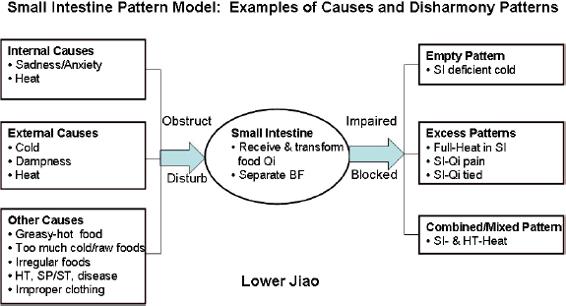
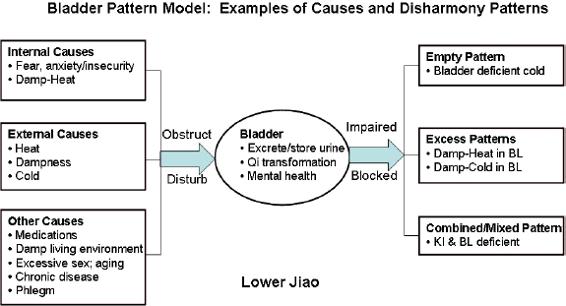
(2) dis-coordination of the Heart and Small Intestine or Bladder and Small Intestine, causing changes in urination.
(b)Bladder (BL)
Often manifested as malfunction of blood fluid transformation/excretion — abnormal urination, enuresis, etc.
Major clinical manifestations:
Small intestine
- Lower abdominal pain/distension.
- Bowel movement — borborygmus/constipation.
- Scanty dark painful urination (if Heat).
- Mental restlessness, ulcers (if Heat).
- Rapid/Wiry pulse, especially at the left front position.
- Tender pressure points (SI 4, BL 27, RN 4).
Bladder
- Abnormal urination — difficult, painful, burning, abundant/scanty, dark-colored, turbid/cloudy.
- Enuresis, incontinence, sand or stone in urine.
- Thick sticky tongue coating.
- Slippery/Wiry/Weak pulse, especially at the rear positions.
- Tender pressure points (BL 64, BL 28, GV 3).
Diagnosis and differential diagnosis
The diagnosis is made based on information collected through the Four Examinations.
The manifestations related to abdominal pain and abnormal urination may provide directions for Small Intestine and Bladder patterns, respectively.
Like diagnosis for patterns of Zang organs, the diagnosis is ideally made based on the three guidelines.
Differential Diagnosis may be required for some Small Intestine and Bladder patterns, such as:
- Small Intestine-Qi Pain and Small Intestine-Qi Deficiency.
- Heat in the Small Intestine and Heat in the Large Intestine.
- Damp-Heat in the Bladder and Damp-Cold in the Bladder.

